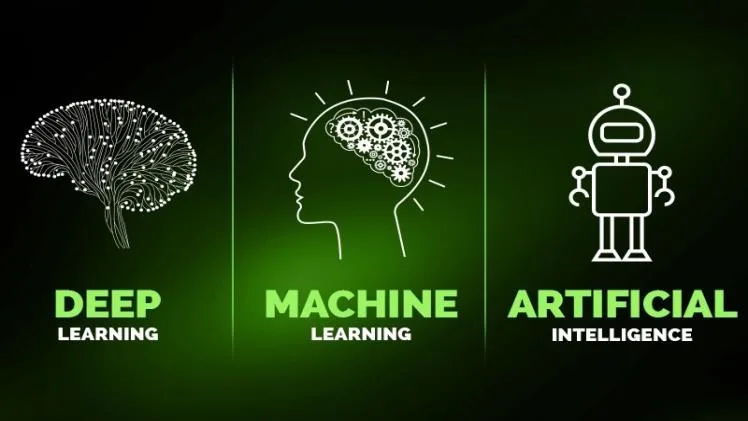Artificial intelligence and machine learning both the terms are both used interchangeably. However, they differ regarding use cases, datasets, and more. We will take you through AI and ML, their definitions, capacities, and practical applications to comprehend the differences between AI and ML.
Critical Characteristics of Artificial Intelligence
1. Generalization:
Artificial intelligence (AI) systems are built to transfer their knowledge from one job or topic to another. A chess-playing AI, for instance, may easily modify its techniques to fit various games.
2. Human-Like Cognition:
The ultimate objective of AI is to reproduce cognitive skills that are unique to humans. This entails comprehending everyday language, seeing patterns, and adjusting to novel and unanticipated circumstances.
Categories of Artificial Intelligence
Two main categories may be used to divide artificial intelligence:
1. Narrow or Weak AI:
Also known as weak AI or narrow AI, this category includes AI systems created with a specific job or issue in mind. They are exceptional in well-defined fields but need help to apply their expertise to other activities. Virtual personal assistants like Siri, chatbots, and recommendation systems used by streaming platforms are all examples of limited AI.
2. General AI: General artificial intelligence (GAI) can do any intellectual job as effectively as a person. General AI aims to create a system that is intelligent enough to think like a person on its own.
AI Techniques and Approaches
AI includes a broad variety of methods and strategies, such as:
- Expert Systems: These rule-based systems mimic the ability of a human expert in a particular field to make decisions.
- Symbolic Reasoning: Symbolic AI employs logic and symbolic representations to address complicated issues. It often relates to inference and knowledge representation.
- Natural Language Processing (NLP): NLP is concerned with giving computers the ability to comprehend, decipher, and produce human language. Applications like chatbots and language translation depend on it extensively.
- Computer Vision: Teaching a computer to read and comprehend visual information from the outside world will enable it to distinguish objects, scenes, and patterns in pictures and movies.
- Robotics: AI-driven robots are made to operate on production lines or conduct hazardous area exploration independently or somewhat autonomously.
Machine Learning: A Subset of AI
Machine learning is a branch of artificial intelligence that focuses on creating algorithms and models that let computers learn from data and form hypotheses or judgments. ML algorithms are designed to examine data, spot patterns, and utilize this information to enhance how well they do specific jobs gradually.
Critical Characteristics of Machine Learning
- Data-Driven Learning: Data are used to train models in machine learning. More high-quality data will improve its performance.
- Generalization: Machine learning (ML) models generalize data patterns to generate predictions or judgments on brand-new, unexplored data.
- Continuous Improvement: ML models may perform better as they are exposed to additional data and learn from their errors.
- Automation: ML models may do tasks automatically without being specifically trained for each unique situation. They are, hence, adaptable for a variety of applications.
Categories of Machine Learning
There are three main categories of machine learning:
- Supervised Learning: Each input is paired with a matching output in a labeled dataset. When given fresh, unexplored data, the model learns to map inputs to outputs, enabling it to make predictions or assign categories. Sentiment analysis, spam email detection, and picture recognition are common uses.
- Reinforcement Learning: In reinforcement learning, an agent interacts with its environment and picks up new information by getting feedback through rewards or punishments. By doing activities that produce desired results, the agent aims to maximize cumulative rewards. Applications for reinforcement learning may be found in autonomous robots, gaming (such as AlphaGo), and recommendation systems.
Machine Learning Algorithms
Machine learning algorithms come in a broad range of applications and complexity. ML algorithms that are widely used include:
- Linear Regression: Used to forecast an ongoing result based on one or more input characteristics.
- Decision Trees: Hierarchical, tree-like structures that use a route from the root node to a leaf node to make judgments.
- Random Forest: An ensemble learning technique that mixes many decision trees to increase precision and decrease overfitting.
Critical Differences Between AI and ML
After thoroughly examining both AI and ML, let’s now point out their main distinctions:
1. Scope:
- AI is a vast area that includes developing intelligent systems resembling human cognitive processes.
- Machine learning is a branch of artificial intelligence that focuses on data-driven learning and creating algorithms that improve over time.
2. Learning Approach:
- AI uses methods other than machine learning, such as expert systems, symbolic reasoning, and natural language processing.
- To create predictions or judgments, machine learning generally uses data-driven learning.
3. Autonomy:
- AI systems have the potential to learn from data or not. Some artificial intelligence systems are rule-based and don’t need data to learn.
- Data is a prerequisite for machine learning systems’ training and ongoing enhancement.
- Generalization:
- Machine learning (ML) models are created to generalize data patterns to generate predictions or judgments on brand-new, unexplored data.
- Because specific AI systems are specialized for particular tasks, they may not consistently demonstrate this generalization capacity.
The Future of AI and ML
The domains of AI and ML are still developing quickly, and exciting new developments are on the horizon. Here are some potential future trends and developments in AI and machine learning development services in USA:
- Explainable AI (XAI): Improving the interpretability and transparency of AI models to make their judgments more understandable and reliable, particularly in crucial industries like banking and healthcare.
- Addressing ethical issues and biases in AI systems to assure justice and prevent unintentional prejudice in decision-making.
- AI in Edge Computing: Adding AI functionality to edge devices, such as smartphones and Internet of Things (IoT) devices, to enable real-time processing and decision-making without relying on cloud resources.
- Quantum Computing and AI: Investigating how AI training might be sped up and how big issues now intractable by conventional computers could be solved using quantum computing.
- Using AI and ML for Scientific Research: Using AI and ML to speed up scientific research in areas like medicine development, materials science, and climate modeling.
- AI in creation: AI-generated content innovations in the arts, music, and literature erode the distinction between human and machine creation.
In conclusion, although machine learning and artificial intelligence development services in USA have similar aims of enhancing the capabilities of computer systems, they are two distinct subfields in computer science. In contrast to ML, which focuses on data-driven learning to make predictions and choices, AI incorporates the lofty goal of building intelligent computers with cognitive skills similar to humans. AI and ML are reshaping technology’s present and future, altering whole sectors and how people interact with technology and data. If you are also looking to hire blockchain developer in USA, contact us now!



